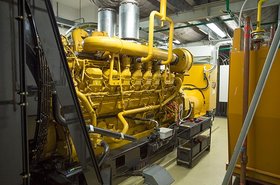Operators' most common net-zero energy policies have no long-term effect on carbon emissions, according to researchers, who say large customers should move to "temporal" or 24/7 energy matching.
Hyperscale data center operators are the biggest voluntary clean energy consumers, attempting to directly consume green energy, and paying for renewable sources to match their emissions. However, their net-zero activities only consider their own use, and ignore their impact on the grid as a whole. The most usual ways they match their energy or emissions will have close to zero effect on long-term emissions reduction for the grid, according to a working paper released last week by Princeton University's ZERO Lab.
Time-based procurements, which match energy use hour by hour with green energy, drive real cuts in carbon emissions from the power grid - but they cost up to $20 per MWh more, depending on where and how the energy is procured.
Net-zero in isolation
Data center operators all aspire to net-zero emissions and use renewable energy purchases to progress towards that goal. The ZERO group's research, System-level Impacts of Voluntary Carbon-free Electricity Procurement Strategies, examined the overall impact of their actions on the total grid in two sample US states (California and Wyoming) to create a bigger picture which showed that large energy purchases can have unintended results. They can simply displace emissions, or fail to stimulate net new energy production.
Hyperscalers, such as Google, Amazon, Meta and Microsoft, are the biggest buyers of power purchase agreements (PPAs) in which a customer pays for a quantity of new renewable generation, which it can then offset against its own use. US commercial and industrial consumers bought 11GW of PPAs in 2021. Worldwide, hyperscalers bought 31GW in that year. Amazon leads that field, buying 8.3GW of PPAs in 2022.
PPAs are better regarded than previously popular renewable energy certificates (RECs) which sometimes paid operators for long-built generating resources, rather than new capacity.
To make better clean energy purchases, large customer have moved to match their energy use better. Many net-zero strategies simply buy an equivalent amount of energy to their actual load. This "volumetric" matching is flawed, because the customer will use energy at different times of day from the energy produced by solar farms and wind turbines.
But the attempts to match this are not equally good. Some customers are attempting "emissions matching," which buys more green energy and matches the total carbon intensity to that of the power it uses. Other organizations use "temporal matching" which attempts to match the emissions created by the customer's energy use, hour-by-hour, a scheme known as 24/7 matching.
Approaches to clean energy procurement that seem intuitive can have little or no effect on greenhouse gas emissions in practice, Wilson Ricks, a doctoral candidate at Princeton and one of the report’s authors, told Utility Dive.
Match by volume, emissions... or 24/7?
Simply put, emissions matching, used by Amazon, Meta, Salesforce, and General Motors, has little effect on overall emissions. The customer will buy up large amounts of the cheapest green energy available, which would have been commissioned in any case, and give little incentive to add real new capacity.
By contrast, temporal matching creates a demand for firm low-carbon energy production because it forces energy provision in hours when the grid would otherwise have to fall back on fossil power. This will either be met by firm generating capacity such as hydro or nuclear, or else through long-duration energy storage (LDES). Temporal matching is used much less often, but Microsoft and Google have announced plans to move to 24/7 matching, while Iron Mountain has signed 24/7 PPAs. President Biden issued an executive order in December 2021 requiring federal agencies to procure 100 percent carbon-free electricity by 2030, with half of this procurement matched hourly with consumption.
"While each of these three matching strategies provides an accounting framework under which voluntary buyers of carbon-free electricity can claim reductions in emissions, our results illustrate the extent to which these claims correlate with actual changes in system-wide CO2 emissions," said the researchers. "We find that in the current U.S. policy environment, both volumetric and emissions matching procurement strategies drive little to no change in system-level CO2 emissions compared to counterfactual scenarios where no voluntary procurement occurs."
"While both matching strategies implicitly assume that this procurement offsets CO2-emitting fossil-fired generation, we find that it instead almost exclusively displaces capacity additions and generation from other renewable resources," they continued. "In other words, all or nearly all of the carbon-free energy procured by voluntary market participants pursuing volumetric or emissions matching strategies would have been generated anyway."
The volumetric and emissions matching schemes are very cheap, so that participants can "very easily claim zero emissions" at almost no cost, "without making any real contributions to electricity decarbonization overall."
Temporal matching works better because "meeting a high temporal matching target requires procurement of carbon-free generation even in hours when it would otherwise be more cost-effective to meet electricity demand with fossil-based generation than with new clean power."
It also promotes advanced clean firm generation and storage that would not otherwise be deployed in the near term, the researchers said. "Voluntary 100 percent temporal matching commitments could thus provide early markets for the nascent technologies that will likely be critical components of fully-decarbonized electricity systems in the long run, allowing for earlier scale-up and cost reductions via learning curve effects."
The paper used GenX, an open-source energy procurement model from MIT and Zero Labs. It had full editorial independence, but was funded in part by a grant from Google and by the Princeton Zero-carbon Technology Consortium, which is supported by gifts from GE, Google, ClearPath, and Breakthrough Energy.
The paper used data based on commercial and industrial customers in California and in the Mountain West, areas that provide two different environments, solar and gas heavy in California, and wind and coal heavy in Wyoming and Colorado. The authors say the results should be consistent across the US.




